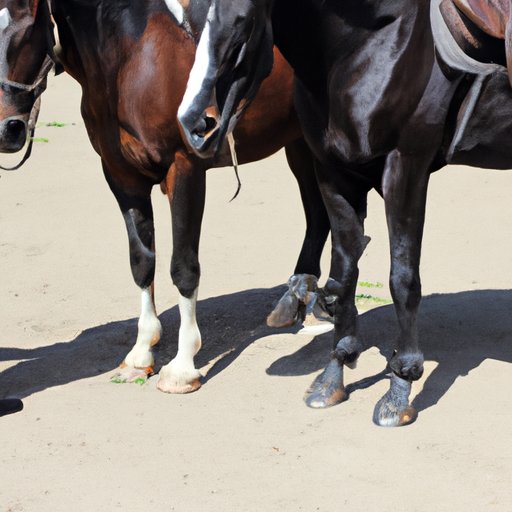
Introduction
Horseback riding is a unique and exhilarating activity loved by many around the world. Not only is it a form of exercise, but it also offers a chance to connect with horses and explore the great outdoors. If you have always wanted to try horseback riding but don’t know where to start, this guide is for you. In this article, we will take you through the basics, including how to select a horse, how to mount and dismount, how to ride and perform techniques, and the benefits of horseback riding.
Step-by-Step Guide
Horseback riding is an experience that requires the right horse, proper equipment, and the necessary skills to ride effectively. Here are some steps to get you started:
Horse Selection
The first step in riding a horse is selecting the right horse for your needs and experience level. You need to consider the breed or type of horse you want to ride based on your experience, weight, and height. Horses differ in temperament, athleticism, movement, and disposition. It is important to find a horse that meets your needs and is healthy. You can observe the horse’s demeanor, appearance, fitness, and willingness to interact with you to evaluate it.
Preparing to Mount
Before mounting the horse, you need to prepare the horse and check that you have all the necessary equipment, including a saddle, bridle, lead, girth or cinch, stirrups, and reins. You need to groom your mount, brush its body, mane, tail, clean its hooves, and secure its hair. This is also the time to get to know the horse and establish a bond before riding. Experienced riders call it horse bonding.
Mounting
Mounting is the process of getting onto the horse for the ride. For beginners, mounting can be daunting, but it doesn’t have to be. Start by standing on the horse’s left side with the reins in your hand, and position your left foot in the stirrup. Next, swing your right leg over the horse’s back but avoid hitting it against the horse. Ensure that your left foot is flat on the stirrup and secure your position on the horse’s back.
Riding
Riding a horse is a learned skill, and you become better with time. The first thing to learn is the correct posture and position while riding. You need to balance yourself on the horse to stay steady. Keep your back straight, heels down, knees bent, and eyes forward. Start with walking the horse slowly and building upon it gradually. Practice stopping, steering, and changing direction before you begin to trot and finally canter. It is important to communicate with the horse through sounds and pressure using your reins and leg position, respectively.
Dismounting
Dismounting is just as important as mounting. Before dismounting, ensure that the horse is stationary and comfortable because it can become anxious or restless. Reach your left foot out of the stirrup and swing your right leg over the horse’s back to dismount carefully. Do not jump off the horse, as this can cause injury to both you and the horse.
Interview Approach
We spoke with an experienced horse rider, Tracy, who offered her approach to horseback riding.
According to Tracy, “riding a horse offers a rare opportunity to experience nature, connect with animals, and embark on a physical journey in unique environments.” As a beginner, she recommends finding a good instructor, paying attention to grooming, and taking small steps to learn. She added that “it’s important to listen to the horse, as they communicate through body language, and pay attention to safety at all times.”
When asked about common challenges, she mentioned adapting to different horses, adopting the right posture, and building confidence.
Visual Guide
Horseback riding is easier to understand with a visual guide. The guide includes detailed photos and videos with clear step-by-step instructions on the proper position and techniques. It also features a voiceover explanation or text captions for each movement. This visual guide is excellent for beginners who would like a visual aid to understand the theories and concepts that underlie riding.
Common Mistakes to Avoid
Common mistakes beginner riders make include improper seat and posture, ineffective communication with the horse, forgetting to prepare the horse or check its condition and ignoring safety rules. To avoid these mistakes, always ensure that you have the right gear, listen to the horse’s body language, and start with basic approaches. It is also important to practice with an instructor to eliminate bad habits, have breaks between sessions to prevent exhaustion and to keep track of your progress.
Benefits of Riding
Riding a horse is more than just a fun activity. It has numerous physical, mental, and emotional benefits. For instance, riding offers physical exercise, which burns calories, enhances body strength, improves posture, and boosts balance and coordination. Mentally, horseback riding provides a break from daily stress and reduces anxiety, depression, and trauma. Emotionally, it increases self-esteem, social connections, and a sense of accomplishment.
Conclusion
Riding a horse is an exciting and rewarding activity, but it requires patience, persistence and, most importantly, safety. If you are new to horseback riding, keep in mind that it takes time and practice, and it is essential to start with basic steps before advancing. Take time to bond with your horse, always wear protective gear, and listen to your instructor and horse to stay safe. Horseback riding is a journey worth the effort.




